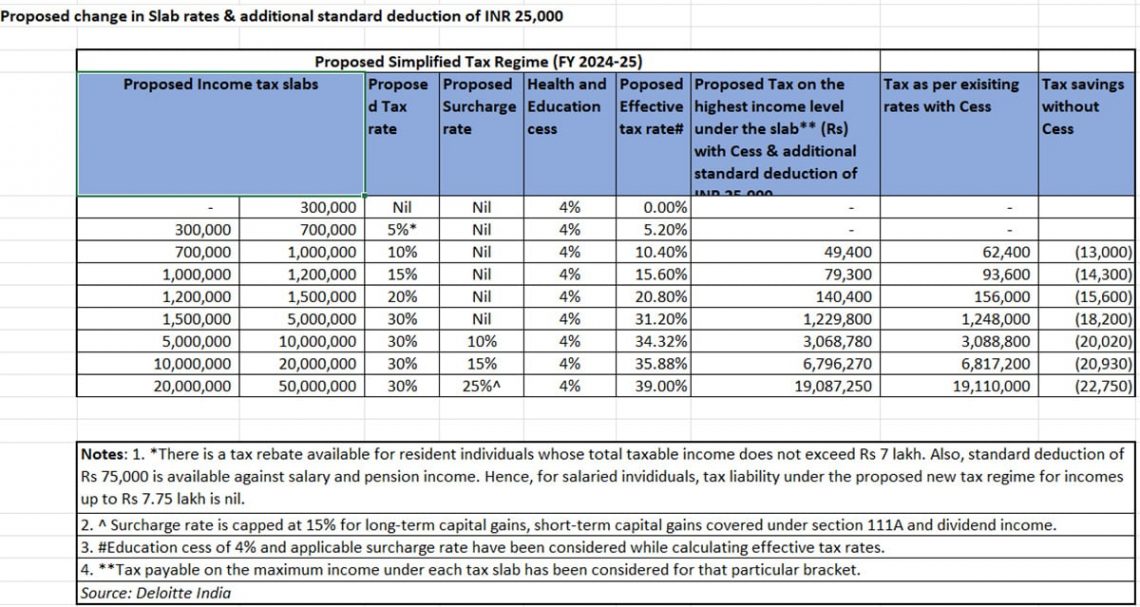The government has introduced a simplified tax regime for the fiscal year 2024-25, aimed at streamlining the tax structure to make it more taxpayer friendly. This new regime introduces revised income tax slabs, rates, and deductions designed to benefit taxpayers across various income brackets.
According to auditing firm and consultant Deloitte, under the just unveiled tax regime, income up to Rs 300,000 will not attract any tax, maintaining parity with the existing system. For income ranging from Rs 300,000 to Rs 700,000, the tax rate is set at 5?per cent, with an effective tax rate of 5.20?per centy, including a 4?per cent health and education cess. A notable feature of the new regime is the tax rebate for resident individuals whose total taxable income does not exceed Rs 7 lakh. Moreover, salaried individuals can avail themselves of a standard deduction of Rs 75,000 against salary and pension income, effectively reducing their tax liability to nil for incomes up to Rs 7.75 lakh. This move is expected to bring substantial relief to middle-income earners, aligning with the government’s objective to enhance disposable income and stimulate economic growth.
For income ranging from Rs 700,000 to Rs 1,000,000, the tax rate is 10?per cent, resulting in an effective tax rate of 10.40?per cent. Taxpayers within this bracket can expect to pay Rs 49,400 under the new regime, compared to Rs 62,400 under the existing rates, leading to tax savings of Rs 13,000. As income increases to the Rs 1,000,000 to Rs 1,200,000 bracket, the tax rate rises to 15?per cent, with an effective rate of 15.60?per cent. Here, the tax payable would be Rs 79,300, offering savings of Rs 14,300 compared to the current regime. Similarly, for incomes between Rs 1,200,000 and Rs 1,500,000, the tax rate is 20?per cent, resulting in an effective tax rate of 20.80?per cent. Tax liability under this slab would amount to Rs 140,400, reflecting savings of Rs 15,600 when compared to existing rates.
As we move to higher income levels, for the range of Rs 1,500,000 to Rs 5,000,000, the tax rate is set at 30?per cent with an effective tax rate of 31.20?per cent. Individuals in this bracket would see a tax liability of Rs 1,229,800 representing a saving of Rs 18,200 compared to the current rates. For those earning between Rs 5,000,000 and Rs 10,000,000, the tax rate remains at 30?per cent, but with a 10?per cent surcharge, resulting in an effective tax rate of 34.32?per cent. This bracket sees a tax payable amount of Rs 3,068,780, offering savings of Rs 20,020 against the existing regime.
For incomes between Rs 10,000,000 and Rs 20,000,000, the tax rate continues at 30?per cent, with a 15?per cent surcharge resulting in an effective tax rate of 35.88?per cent. Tax liability in this range would be Rs 6,796,270 providing a saving of Rs 20,930 compared to current rates. Finally, for those earning between Rs 20,000,000 and Rs 50,000,000, the tax rate remains at 30?per cent accompanied by a 25?per cent surcharge, which is capped at 15?per cent for long-term capital gains, short-term capital gains covered under section 111A and dividend income. This results in an effective tax rate of 39.00?per cent with a tax liability of Rs 19,087,250 offering savings of Rs 22,750 compared to existing rates.
According to Deloitte, the education cess of 4?per cent and applicable surcharge rates have been meticulously considered in calculating effective tax rates ensuring transparency and accuracy in determining tax liabilities across various income brackets. The regime also emphasises enhancing the standard deduction for salaried individuals, which has been increased from Rs 50,000 to Rs 75,000 providing a significant financial cushion that allows taxpayers to reduce their taxable income effectively.
While the regime offers substantial savings for middle-income earners, high-income individuals may experience minimal tax savings. However, the government’s strategic focus on enhancing consumption and investment is expected to contribute to long-term economic growth. By offering tax rebates, enhancing standard deductions, and capping surcharge rates, the government aims to create a balanced system that caters to the needs of various income groups, ultimately contributing to India’s financial well-being.
The simplified tax regime for FY 2024-25 marks a significant step towards a more equitable and efficient tax structure.
Link to article –
Calculation: Will you pay more income tax or less after Budget 2024 changes?

